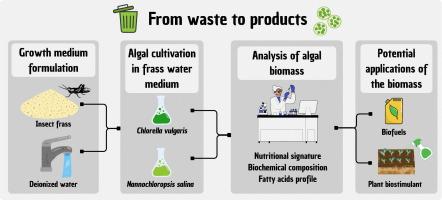From waste to products: microalgal cultivation in insect frass to obtain valuable biomass
Q1 Environmental Science
引用次数: 0
Abstract
Insect frass, a residual by-product of insect farming, is increasingly considered for circular-bioeconomy applications. Here we quantitatively evaluated Acheta domesticus frass as the sole nutrient source for Chlorella vulgaris, Nannochloropsis salina and Phaeodactylum tricornutum, using frass loadings equivalent to control nitrogen supplies (4.12 g L−1 for freshwater species; 250 mg L−1 for marine species) under both autoclaved and non-autoclaved conditions. P. tricornutum did not survive acclimation. In non-autoclaved frass, C. vulgaris reached a μmax of 0.62 d−1 and final cell density of 1.1 × 107 cells·mL−1, similar to control, while N. salina attained 6.5 × 106 cells·mL−1 but with growth rate reduced by ∼50 %. Autoclaving reduced maximum biomass yields by 30–40 % relative to non-autoclaved cultures, although growth rates remained similar. Growth in frass shifted algal biochemical composition toward lower protein content, whereas lipid fractions remained similar to controls. Fatty acid profiles showed increased saturated fatty acids (16:0, 18:0) and reduced levels of 18:2n-6 and 18:3n-3, with an overall decline in PUFA content. In summary, insect frass supported algal growth but yielded lipid characteristics more suitable for biodiesel than for PUFA-rich feed.

从废物到产品:在虫粪中培养微藻以获得有价值的生物质
昆虫草是昆虫养殖的残余副产品,越来越多地被认为是循环生物经济的应用。本研究在高压和非高压条件下,利用相当于控制氮供应(淡水物种为4.12 g L−1,海洋物种为250 mg L−1)的碎屑负荷,定量评估了家草作为普通小球藻、盐绿纳米藻和三角褐指藻的唯一营养来源。三角草没有在驯化中存活下来。在未经过高压处理的杂草中,普通草的μmax为0.62 d - 1,最终细胞密度为1.1 × 107个细胞·mL - 1,与对照相似,而盐藻的μmax为6.5 × 106个细胞·mL - 1,但生长速度降低了约50%。与非高压灭菌培养物相比,高压灭菌降低了最大生物量产量30 - 40%,尽管增长率保持相似。杂草的生长使藻类的生化组成向蛋白质含量较低的方向转变,而脂质部分与对照组保持相似。脂肪酸谱显示饱和脂肪酸(16:0,18:0)增加,18:2n-6和18:3n-3水平降低,PUFA含量总体下降。综上所述,虫草支持藻类生长,但其脂质特性更适合用于生物柴油而不是富含pufa的饲料。
本文章由计算机程序翻译,如有差异,请以英文原文为准。
求助全文
约1分钟内获得全文
求助全文
来源期刊

Bioresource Technology Reports
Environmental Science-Environmental Engineering
CiteScore
7.20
自引率
0.00%
发文量
390
审稿时长
28 days
 求助内容:
求助内容: 应助结果提醒方式:
应助结果提醒方式:


